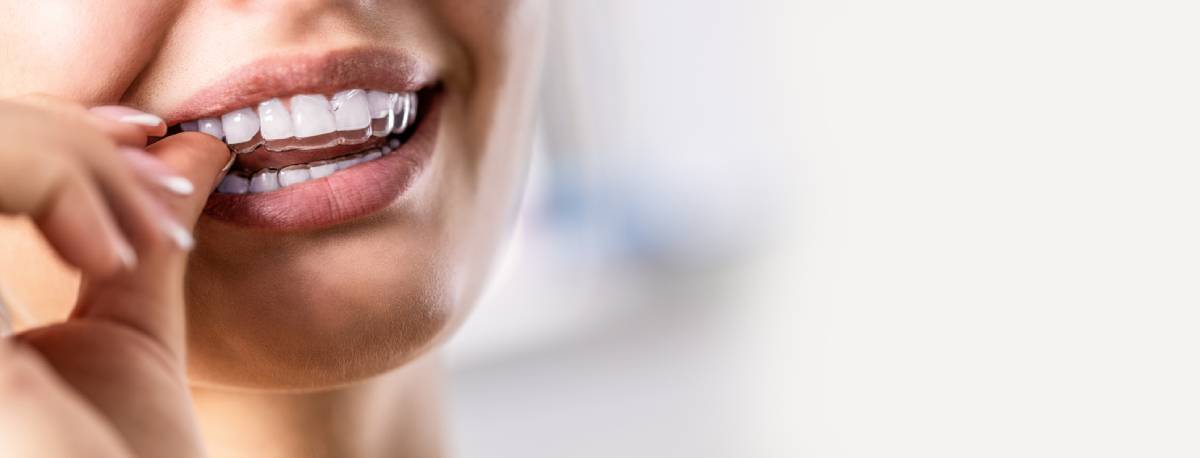In recent years, Invisalign has gained enormous popularity for treating various orthodontic issues because it is practically invisible in the mouth while being highly effective. But how does Invisalign work? Please read our article to learn the answer to this question and about the advantages and disadvantages of Invisalign aligners.
How Does Invisalign Work?
Invisalign aligners are transparent trays made of medical-grade plastic (a blend of polyurethane resins). Like most orthodontic treatment methods, Invisalign works by applying pressure to your teeth in areas strategically chosen by your dentist. Over time, this pressure causes your teeth to move, gradually taking their correct position.
To achieve the desired results with Invisalign treatment, it is crucial to wear the aligners for the recommended 22 hours a day, taking them off only for eating and cleaning. It can be tempting to remove your aligners more often than necessary, as the treatment will inevitably cause some pain or discomfort. However, for the teeth to move, the pressure applied to them should be constant.
In general, orthodontic treatment with Invisalign takes between one year and 18 months. However, in cases of minor misalignment, the treatment can be finished in as little as 6 months. On the other hand, complex cases may require up to 2 years or even longer to complete treatment with aligners.
Invisalign clear aligners can be successfully used to treat the following orthodontic issues:
- Crooked teeth and misaligned teeth
- Overcrowded teeth
- Overbite and underbite
However, Invisalign might not be the best orthodontic solution for every patient. Your dentist will be able to accurately determine if Invisalign will work in your case after a comprehensive examination of your teeth and bite.
Advantages of Invisalign
- Invisalign aligners are transparent and much less noticeable in the mouth than traditional braces.
- According to patients’ reports, Invisalign is more comfortable than traditional braces because it does not have metal parts, thus rubbing less. Additionally, it is believed to cause less tooth soreness compared to braces. However, you are still likely to experience occasional pain and discomfort when teeth move through the jawbone.
- Invisalign aligners are removable during meals, making eating more enjoyable and preventing food from getting stuck in your orthodontic appliances. Additionally, you will not have any dietary restrictions, unlike those who wear braces.
- Due to the fact that Invisalign can be removed at will, it is much easier to clean aligners themselves and maintain adequate oral hygiene than when you wear traditional braces. In fact, wearing braces can pose a risk of cavities and gum disease because it can be challenging to clean your teeth effectively.
- Treating misaligned teeth with Invisalign typically requires fewer visits to the dental office than with traditional braces. Typically, your dentist will provide you with several sets of Invisalign trays, which you can change by yourself according to the established schedule, only occasionally visiting your dentist for a progress checkup. In comparison, braces require frequent, sometimes weekly, adjustments.
Disadvantages of Invisalign
- Invisalign might not be suitable for treating complex and severe cases of misalignment or bite issues. Typically, this method is chosen for more straightforward cases, while metal braces that can withstand considerable pressure are used for complex ones.
- Wearing Invisalign requires discipline and commitment. As we mentioned earlier, if you do not wear your aligners consistently, you are unlikely to achieve the desired results. If you expect you will be unable to strictly adhere to wearing Invisalign for at least 22 hours a day, it is better to opt for traditional braces that are permanently attached to the teeth and can not be removed at will.
How Orthodontic Treatment with Invisalign Can Benefit Your Health
Some people believe that the primary benefit of orthodontic treatment is a beautiful smile. Contrary to this belief, there are many oral and general health benefits orthodontics can offer:
- Straighter teeth are easier to clean, which makes your oral hygiene routine more effective. As a result, you can enjoy healthy teeth and gums for years to come.
- Good oral hygiene helps prevent infections in the mouth, which in turn benefits the overall health of your body. Oral infections are closely associated with gastrointestinal, cardiovascular, joint, and lung health issues.
- Improper bite and teeth misalignment can lead to uneven teeth wear, TMJ dysfunction, muscle tension, facial asymmetry, headaches, and neck and back pain. Thus, straightening your teeth and fixing your bite can help you avoid such issues in the future or treat the existing problems.
Get Orthodontic Treatment at Dental Care of Chino Hills
Start your orthodontic treatment today by scheduling an appointment with an experienced dentist at Dental Care of Chino Hills. We will carefully examine your case to provide you with an effective orthodontic solution that meets your goals, needs, and budget. We look forward to your visit.

